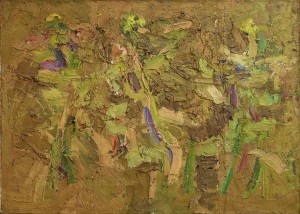EXHIBITION GUIDE “The free way. Abstract and informal art of the Fifties in Italy
The free way.
Abstract and informal art of the Fifties in Italy
by Marco Bazzini
Translation by Mia.S.Hernandez, University Of Oklahoma
a
Between the end of the Second World War and the beginning of the fabulous Sixties, spanning about a decade, Italy was a nation committed to overcoming the material ruins inflicted by the conflict on its cities, as well as the intangible damage inflicted on its economy and civil society. The prevailing ethos was one of: rebuilding. It was a collective obligation embraced by all Italians, leaving no sector untouched. Reconstruction became a necessity, breathing new life into the nation, guided by the principles laid down in the Democratic Constitution, which came into force on January 1, 1948.
In what in the early years of the Republic can be imagined as abandoned uncultivated territory, new forces, and different cultural consciousnesses also began to come to life. Representing the most vivid reaction to the insufferable restrictions experienced during the twenty years of fascism. The awakening of the arts takes place through multiple experiences that do not spare heated controversy in a debate led by opposing fronts. Thus, beyond adherence to different or similar political or poetic orientations, it constitutes proof of the true vitality and revival of Italian art. In fact, it is difficult to think of the fifties as a time when everything happens in a linear progression because they are years in which becoming is chaotic, especially in art, which mirrors this chaos. They are years in which several directions are followed, where everything flows from a dialectic between several fires, sometimes close to each other, and sometimes very distant. A heterogeneous mass of conflicting opinions and practices gives rise to a legacy of values and experiences that pollinate the following decade like bees. In this perspective, the knowledge of this first post-war period, of which this exhibition presents the works of some of the protagonists who have developed a language that must respond to the new society, is essential. Not only for the great and varied expressiveness and quality with which it is articulated in the various manifestations, but also for the understanding of the research that follows, starting from that of the sixties, when, in the words of the artist Fabio Mauri (1926-2009), ‘the Fifties were…- 10 years old”.
At the end of the war, Italian artists were almost completely unknown abroad, just as in Italy little is known about what happened outside the national borders. The international update passes through the Venice Biennials, starting with that of 1948, or the Milan Triennials, the revival takes place in 1951, or even through some admirable returns such as that of Lucio Fontana (1899-1968) and Mario Ballocco (1913-2008) from Argentina or Corrado Cagli (1910-1976) from the USA, or even the critic Lionello Venturi (1885-1961) who in the early thirties had taken the road to exile. From the first part of the century, artists recovered abstractionism and the intimacy of some “exceptions” that deviate from the official norms as well as a return to the “realism” developed by the Corrente movement .
Abstract and real, in the figurative dimension, are the two fronts that divide the scene of these post-war years in a broader panorama. They battle in a lacerating controversy, marked by positions taken through the signing of posters or articles, both sides intending to indicate the only way forward. As for the realists, the path to follow is that of post-cubism, particularly influenced by Picasso’s lesson in “Guernica,” a work of civil commitment that was also exhibited at the Palazzo in 1953 – Reale in Milan. A position that “makes artists ‘administrators’ of the image rather than creators.” However, both opposing positions aim to be committed and are not entirely devoid of ideological stances. This exhibition voluntarily skips this debate and aspect of history, focusing solely on the creative and propulsive tendencies that explore new expressive categories in non-figurative art. The new proposals made by the artists, almost simultaneously, follow the paths of abstraction and informality, giving birth to shared poetics and group affiliations. Nevertheless, individualities also prevail, either as roots or as embryonic anticipations for the years to come. Informal and abstract art wants to be open and anti-authoritarian, pluralistic in signs and materials, labyrinthine in its progress through gestures and actions, individualistic and poetic. An art where the game of associations prevails, where everything takes place “as if”, where the relationship with the world is variable and where the material of reality meets or reality becomes objective. What is denied is not the form but its univocality, the form becomes a field of possibilities that finds a thousand streams to be lightened or kneaded, intersected or made autonomous, elisa or strengthened, all according to the “free way” of each individual artist. A manner, therefore, that is far from the imitation of models or precise rules, a meaning that over time has corrupted the term with which Giorgio Vasari in his “Lives” defines the expressiveness of the individual artist.
Considering the new course of art, the exhibition opens by presenting the experience of two personalities who were already protagonists of the first part of the century: Alberto Magnelli (1888-1971) and Corrado Cagli. Both have now reached a mature language, the first loosens an excessively rigid arrangement of forms while the second in the fragmentation of the image seems to suggest a liquidity of the form. A new plastic dimension of space is the openness to new possibilities experimented by Lucio Fontana since the late 1940s.
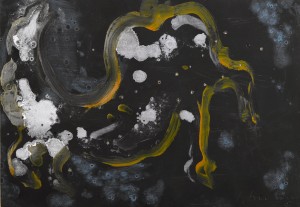
Counted among the informal artists, the father of spatialism manages to bring together abstract forms, drips and the overcoming of the surface through the breakthrough of his now famous “holes”. Spatial art that reflects the new condition of man shaped by new scientific and technological discoveries also inflamed younger artists such as Edmondo Bacci (1913-1978 ), Gino Morandis (1915-1994) and Gianni Dova (1925-1991). Tancredi (Tancredi Parmeggiani, 1927-1964) with his dense and repeated signs in a circular structure also evokes distant galaxies in the paintings of these years and then devotes himself to a lyricism of sign and color.
Carla Accardi (1924-2014) and Antonio Sanfilippo (1923-1980) move towards the excitement of the sign through the immediate transfer of cerebral processes to the canvas, overcoming the lyrical side with their “italics”, while Dorazio and Turcato resort to dynamic chromatic structures and Achille Perilli, their travelling companion in the Forma group at the end of the forties, slows down every trace in the elementary nature of the doodle as the decade turns.
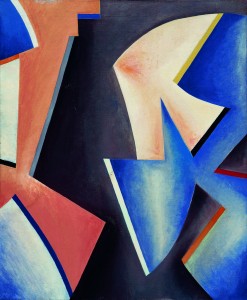
Alberto Burri (1915-1995) reverses the perspective in the direction of matter, ostentatiously showing its hidden aspects to suggest, without any complacency, an aesthetic effect and a tragic existence of man.
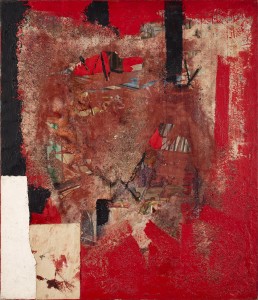
On the other hand, how much tension the anguish of an existential and political condition can discharge appears in the force of impact between painting and canvas expressed by Emilio Vedova (1919-2006). Diaphanous traces are those of Afro (Afro Basaldella, 1912-1976) where a landscape seems to take shape in a structure of glazes and spots.
Artists also contribute to plumbing these new dimensions of research with a strongly autonomous sensibility. In addition to Accardi, works by Carol Rama (1918-2015), Renata Boero (1936), Regina (Regina Cassolo Bracchi, 1894-1974) and Paola Levi Montalcini (1909-2000) are on display.
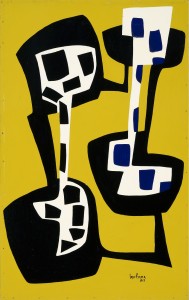
The latter is interested in a dreamlike depiction of a restless universe, while the former in the middle of the decade is endowed with great compositional freedom and an elegant chromatic sensitivity. Regina is engaged in a work of reduction to elementary school, lightening the sculpture to the point of making it a sign in space through unusual materials. Enrico Baj (1924-2003) and Guido Biasi (1933-1982) were guided in their informal exploration by a nuclear sensibility that feeds on microorganic forms or infinite spaces.
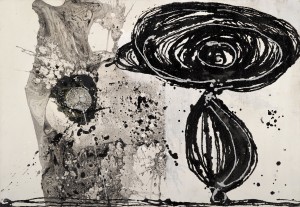
Gillo Dorfles (1910-2018), Bruno Munari (1907-1998), Atanasio Soldati (1896-1953) and Gianni Monnet (1912-1958) are not abstract but concrete art, i.e. aimed at the construction of a new reality that goes beyond any possible reference to reality.
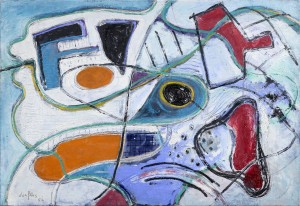
A
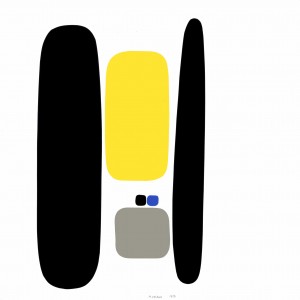
But in that proceeding without project that unites the poetics of those years, there are those like Birolli and Morlotti who still look at nature, reproducing it with dense pictorial surfaces of color. Finally, at the end of these fluid and contrasting years, a nucleus of artists appears to warm themselves to the fire and incandescence of these processes that have transformed matter, space, and sign, but that from these premises in the space of a few years leap beyond the informal and abstract to guide the research of the following decade in which new and different pictorial dimensions are still conquered. Toti Scialoja with his footprints, Gastone Novelli with his white and his graphemes, Mario Nigro with his sympathetic rhythms and Enrico Castellani with a different restlessness of the canvas that already looks to a vocation towards the absolute, are but the first witnesses of an energetic space from which we draw to connect the present to the future.
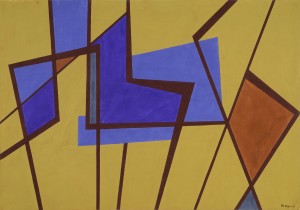
a
“La libera maniera” is an exhibition that presents the diversified and multifaceted action that some artists carried out during the fifties, a fundamental period for the development of Italian art that the Intesa Sanpaolo collections recognize for its importance and of which they preserve a rich and well-nourished collection of works, much more numerous than what has been selected on this occasion. A selection that follows not only the undisputed artistic quality but also the “document” of a fruitful and free time capable of imagining and building a new nation.
